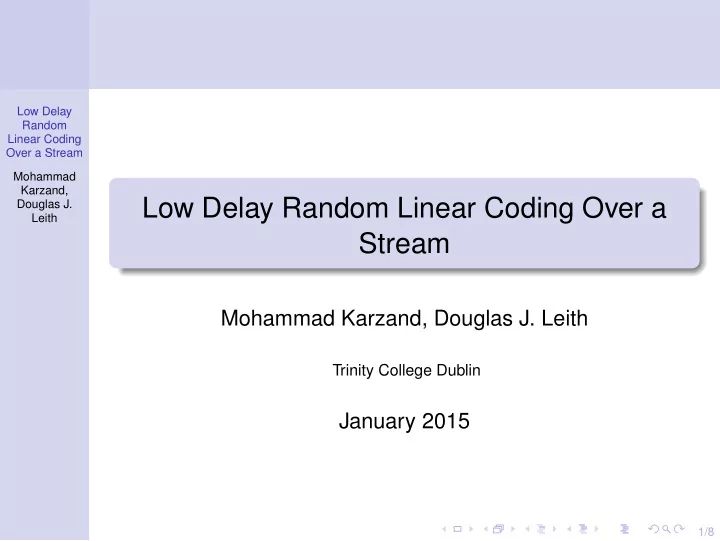

Low Delay Random Linear Coding Over a Stream Mohammad Karzand, Low Delay Random Linear Coding Over a Douglas J. Leith Stream Mohammad Karzand, Douglas J. Leith Trinity College Dublin January 2015 1/8
Motivation Low Delay Random Linear Coding Over a Stream Observation: TCP performs poorly Mohammad Karzand, In the presence of interference. Douglas J. Leith Large round trip time. High packet loss rates over the networks. Solution: A transport layer solution referred to as Network Coded TCP . Benefits: Backward compatibility with legacy equipment and easy implementation. Issue: In-order delivery delay, very important for multimedia communications. 2/8
The Idea Low Delay Random Put one coded packet after l − 1 information packets Linear Coding Over a Stream Mohammad Karzand, Douglas J. Leith Coded Packet: Random linear combination of all preceding information packets. ( l − 1 ) . i � c i := w ij · u j j = 1 w ij are drawn from an alphabet with cardinality of Q . Q Large: One coded packet decodes one erasure in the past. 3/8
Delay and Busy Period Low Delay Random Example: Linear Coding Over a Stream Mohammad Karzand, ~ t i t i T i Douglas J. Leith ⎧ ⎨ ⎩ ⎧ ⎨ ⎩ busy period idle period Erasure: Decoding procedure starts Definition S = k if the k -th coding packet puts an end to the decoding. In this case S = 2 S i , the busy/idle periods, are i.i.d and form a renewal process. 4/8
Main Theorem Low Delay Random Theorem (Busy Time) Linear Coding Over a Stream We have: Mohammad Karzand, Douglas J. Leith P ( S = 0 ) = ( 1 − ǫ ) l − 1 I. (1) P ( S = 1 ) = ( l − 1 ) ǫ ( 1 − ǫ ) l − 1 (2) P ( S = k ) = l − 1 � ( k − 1 ) l � ǫ k ( 1 − ǫ ) k ( l − 1 ) , ∀ k > 1 (3) k k − 1 E ( S ) = ( l − 1 ) ǫ ( 1 − ǫ ) l − 1 II. (4) 1 − l ǫ E ( S 2 ) = E ( S ) + l ( l − 1 ) ǫ 2 ( 1 − ǫ ) l (5) ( 1 − l ǫ ) 3 5/8
Simulation Results Low Delay Measured in-order delivery delay and upper bound vs Random Linear Coding coding rate ( l − 1 ) / l and packet erasure rate ǫ .: Over a Stream Mohammad Karzand, 5 Douglas J. 10 Leith measured delay ( ε =0.1) bound ( ε =0.1) 4 10 measured delay ( ε =0.05) mean in−order delivery delay (slots) bound ( ε =0.05) 3 measured delay ( ε =0.01) 10 bound ( ε =0.01) 2 10 1 10 0 10 −1 10 −2 10 0.5 0.6 0.7 0.8 0.9 1 coding rate (l−1)/l 6/8
Results II Low Delay Mean in-order packet delivery delay vs packets transmitted Random for random linear block code, and for low-delay coding Linear Coding Over a Stream scheme. Link rate 25Mbps, RTT 60ms, loss rate 10%, cwnd Mohammad Karzand, fixed at BDP . Douglas J. Leith 100 low delay code block size 8 90 block size 16 block size 32 block size 64 80 block size 128 block size 256 Mean in−order delivery delay (ms) 70 60 50 40 30 20 10 0 1.1 1.12 1.14 1.16 1.18 1.2 1.22 1.24 1.26 1.28 1.3 Packets transmitted/Number of information packets 7/8
Recommend
More recommend